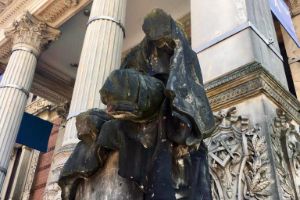YOYI! Care, Repair, Heal, Resonance Room, installation view, Gropius Bau (2022) photo: Laura Fiorio
Resonance Room
YOYI! Care, Repair, Heal
About the Resonance Room
The Resonance Room shared local knowledge and experiences of mental health in Berlin. From 2021 to 2024, a number of projects had developed that question the understanding of and approach to mental health in this city: How do individual health and society interact? How does history affect the present? What forms of care, solidarity and community are designed and practised in urban society? The resonance of different voices from the neighbourhood, academia and civic society could be experienced here. As a meeting place, the Resonance Room gathered these voices and engaged them in dialogue.
The admission is free.
Past Events
Repair, Fractures, Divisions:
The Histories and Presents of the Gropius Bau
Audio Tour
The Gropius Bau and its immediate surroundings are characterised by a multitude of histories. The building housed various institutions over time and is marked by the intertwining of the central violent regimes of the 20th century in Germany: colonial rule, Nazi dictatorship and the division of Berlin have left their traces here. The neglected ruin of the Gropius Bau is considered a sign of new beginnings in post-war Germany. In this audio walk consisting of three parts, students search for hints on how history and the present affect each other.
In/Visibilities
Between visibilities and invisibilities, we follow the tracks of the past of the Gropius Bau and its surroundings. Time has shaped the use of the building: it has been used for research, teaching, exhibiting and propagating different ideologies. What histories can be made visible at this site today? What remains invisible?

© Gropius Bau
Traces
Free spaces, standstills and fractures draw the atmospheres of past histories of the Gropius Bau and its neighbourhood. The Robinia grove is at the core of this audio walk. Contemporary witnesses recount scenes and sentiments in the midst or at the edge of the grove.

© Gropius Bau
Repair
In 1978, reconstruction work began on the war-time demolished Gropius Bau. Repair brings together past, present, and future. What kind of stories do the cracks tell? What do the gaps reveal? This audio walk is dedicated to the atrium and its developments over time.

© Gropius Bau
The research was conducted within the frame of the seminar Reparatur. Brüche. Teilungen. Die Geschichten und Gegenwarten des Gropius Bau of BerlinUniversity Alliance.
Further Projects
Intimate Connections
With Cashmere Radio
This radio broadcast series engages with music’s capacity to help humans cope and develop in manifold ways, individually or collectively. The show was created in collaboration with the Berlin based community radio Cashmere Radio.
Berlin Conversations on Mental Health
Researchers and professionals from the fields of cultural and social work explore the relation between mental health and social inequality within the framework of a filmic research.
Neighbourhood Exchange
The topic of mental health addresses ways of living together. The projects focus on the question: What practices of care do exist in the neighbourhood? Experiences, knowledge and practices related to good neighborly togetherness are shown in the resonance room.
Organisations Participating in the Neighbourhood Exchange
Yekmale.V. Miteinander für die Zukunft, Mina– Leben in Vielfalt e.V, TBBTürkischer Bund Berlin-Brandenburg, Wassertore.V., BauhütteKreuzberg e.V, WillkommensgemeindeSt. Lukas, Zentral-und Landesbibliothek Berlin, outreach.berlin, TAMInterkulturelles Familienzentrum
The Resonance Room was developed by Margareta von Oswald, MindscapesCuratorial Research Fellow, and Diana Mammana, project lead of the Neighbourhood Exchange at the Gropius Bau. Mindscapes is Wellcome’s international cultural programme about mental health.Other project partners are the BerlinUniversity Alliance, CashmereRadio e.V., YeşilÇember, Zentral-und Landesbibliothek Berlin